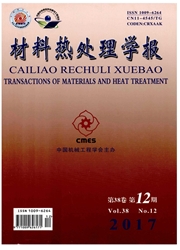

 中文摘要:
中文摘要:
考虑温度对点阵常数的影响,运用固体经验电子理论,在实验时效温度区间,对Al—Cu合金GP区的价电子结构进行计算,并在此基础上计算了GP区与基体间的界面能。计算得到的价电子成键结果表明,Al原子和Cu原子之间的结合倾向最大,在时效过程中,Al和Cu原子容易以GP区形式出现;GP区有较强的共价键络,是Al—Cu合金时效硬化的重要原因;GP区与基体间的共格界面能较低,是GP区生长的有利条件。
 英文摘要:
英文摘要:
Taking into account the influence of temperature on the lattice constant, the valence electron structures of GP zones and the interfacial energy between GP zones and matrix in Al-Cu alloy were calculated using the Empirical Electron Theory in Solid and Molecules ( EET). The results show that Al and Cu atoms exhibit the strongest bonding trends and thus the stronger covalence-bond net forms in the GP zones and causes strengthening due to the formation of GP zones in aging process. The lower interfacial energy between GP zones and matrix is favourable for growing of GP zones.
 同期刊论文项目
同期刊论文项目
 同项目期刊论文
同项目期刊论文
 期刊信息
期刊信息
